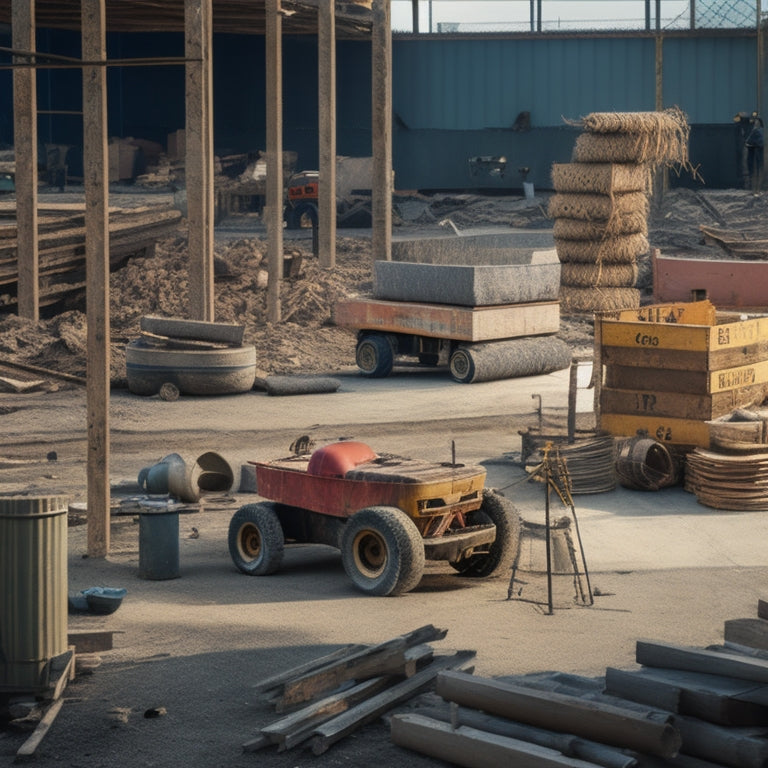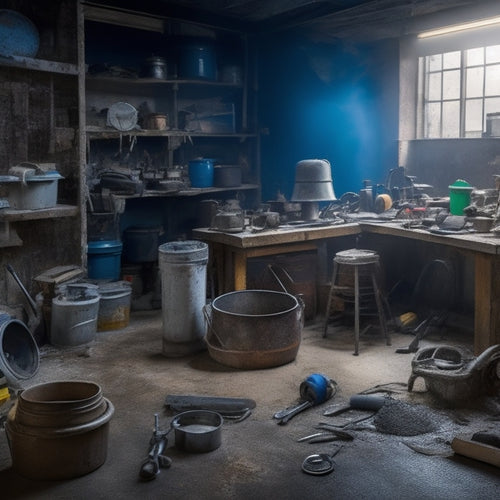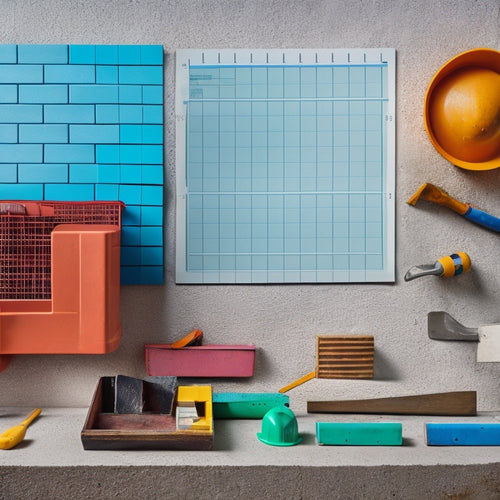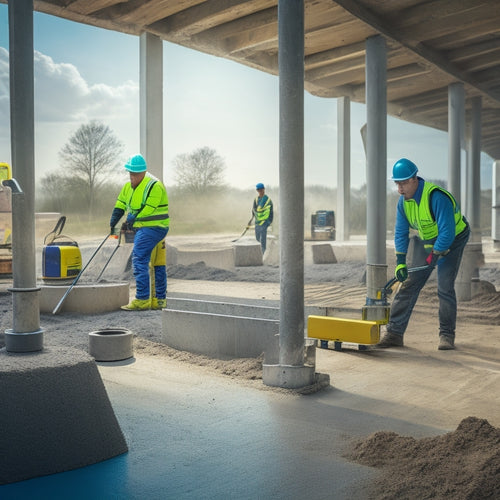
What Tools Do You Need for Concrete Construction
Share
You'll need a range of specialized tools for concrete construction, including measuring and layout tools like laser levels, spirit levels, and squares. Leveling tools, such as laser levels and slope control devices, guarantee accuracy and prevent errors. Tamping and compaction equipment, like plate compactors and vibratory tampers, are crucial for compacting concrete. Mixing and pouring essentials, including concrete mixers and pouring tools, assure a strong structure. Safety gear, like hard hats and protective clothing, are essential on-site. Finishing and demolition tools, including saws, drills, and breakers, help achieve a smooth finish. With the right tools, you'll be well-equipped to tackle your concrete construction project - and understanding how to use them effectively is just the beginning.
Key Takeaways
• Measuring and layout tools like measuring tapes, laser levels, and squares are essential for accurate concrete construction.
• Leveling tools, including laser levels and slope control, ensure a level plane and precise slope control.
• Tamping and compaction equipment, such as hand tampers, plate compactors, and vibratory tampers, are necessary for compacting concrete.
• Mixing and pouring essentials, including concrete mixers, pouring tools, and slump testing, guarantee a uniform mixture and strong concrete structure.
• Safety gear, including hard hats, protective clothing, and safety goggles, is crucial for protecting workers from hazards on the construction site.
Essential Measuring Tools Needed
When preparing for a concrete construction project, you'll need to verify you have the following important measuring tools at your disposal to guarantee accurate calculations and precise execution.
A good measuring tape is a fundamental tool that'll help you measure distances, widths, and heights accurately. It's imperative to choose a tape that's durable, resistant to corrosion, and has clear markings for easy reading. A 25-foot or 30-foot tape is usually sufficient for most concrete construction projects.
Another essential tool is a laser level, which guarantees you're working on a level plane. This device projects a precise level line or dot, allowing you to check the accuracy of your work. A laser level is particularly useful when working on large areas, such as foundation layouts or slab pours. It's important to choose a laser level that's accurate, reliable, and easy to use.
With these two important measuring tools, you'll be well-equipped to tackle your concrete construction project with confidence. By having the right tools, you'll minimize errors, reduce waste, and guarantee a high-quality finish.
Leveling Tools for Accurate Work
You'll need a range of leveling tools to guarantee accurate work, starting with a spirit level that provides a precise horizontal or vertical reference plane.
Spirit level accuracy is essential in concrete construction, as even minor deviations can lead to structural issues. When choosing a spirit level, look for one with high accuracy ratings and a durable design that can withstand harsh job site conditions.
In addition to spirit levels, laser levels offer several advantages in concrete construction. Laser levels project a level line or plane, allowing you to quickly and accurately check the levelness of surfaces over long distances.
This is particularly useful when working on large projects or when multiple workers need to reference the same level plane. Laser levels are also ideal for tasks that require precise slope control, such as installing drainage systems or creating wheelchair ramps.
Tamping and Compaction Equipment
Proper tamping and compaction of freshly poured concrete are critical to achieving a strong, durable, and crack-resistant slab. The right equipment is essential for getting the job done efficiently. You'll need the right tools to guarantee that your concrete is properly compacted, which involves removing air pockets and excess water from the mixture. This process helps to prevent settlement cracks and guarantees a smooth, even finish.
Here are the essential tamping and compaction equipment you'll need:
-
Hand tampers: These are long-handled tools with a flat or curved plate on the end, used for compacting small areas and getting into tight spaces.
-
Plate compactors: These are walk-behind or ride-on machines that use a vibrating plate to compact large areas quickly and efficiently.
-
Vibratory tampers: These tools use a vibrating action to compact concrete and are particularly effective for compacting concrete in tight spaces or around obstructions.
- Rammers: These are handheld tools that use a pneumatic or gasoline-powered piston to deliver a high-impact force, ideal for compacting soil or gravel bases before pouring concrete.
Mixing and Pouring Essentials
To guarantee a strong and durable concrete structure, you must start with a well-mixed and accurately poured batch, which requires the right equipment and a solid understanding of the mixing and pouring process. A concrete mixer, whether it's a drum mixer or a tow-behind mixer, is essential for combining cement, aggregate, and water into a uniform mixture. You'll also need a range of tools for pouring, including a pouring bucket, chute, or pump, depending on the size and complexity of your project.
| Mixing Techniques | Pouring Methods |
|---|---|
| Slump testing | Hand pouring |
| Vibration mixing | Pumping |
| Overmixing avoidance | Chute pouring |
When it comes to mixing techniques, slump testing guarantees the right consistency, while vibration mixing helps to eliminate air pockets. Avoid overmixing to prevent weakening the concrete. For pouring, hand pouring is suitable for small projects, while pumping is ideal for large, complex pours. Chute pouring is another option for more precise control. By mastering these mixing and pouring essentials, you'll be well on your way to creating a strong, durable concrete structure that meets your project's requirements.
Safety Gear for Construction Sites
As you prepare for a concrete construction project, you know that safety comes first.
You'll need to prioritize the right safety gear to protect yourself and your team from hazards on the site.
Let's take a closer look at the essential safety gear you'll need, including hard hat requirements and protective clothing options.
Hard Hat Requirements
When you step onto a construction site, you must wear a hard hat that meets the Occupational Safety and Health Administration's (OSHA) strict guidelines for impact and penetration resistance. This isn't a suggestion, it's a requirement, and for good reason. Hard hat regulations are in place to protect you from falling objects, debris, and electrical hazards that can cause serious head injuries.
Here are the essential hard hat requirements you need to know:
-
Type I Hard Hats: These are the most common type, designed to protect against falling objects and debris.
-
Type II Hard Hats: These hard hats provide additional protection against lateral impact, making them ideal for sites with heavy machinery or equipment.
-
Hard Hat Classes: Hard hats are classified into three classes: Class G (general), Class E (electrical), and Class C (conductive). Guarantee you choose the right class for your site's specific hazards.
- Inspection and Maintenance: Regularly inspect your hard hat for damage, cracks, or signs of wear. Replace it immediately if you notice any issues.
Protective Clothing Options
You wear protective clothing to prevent injuries from cuts, abrasions, and heat stress, which can be just as debilitating as a head injury. As a concrete construction worker, you're constantly exposed to hazardous materials and situations. That's why it's crucial to wear the right gear to guarantee your safety.
Start with protective gloves, which should be durable, flexible, and resistant to cuts and abrasions. Look for gloves with reinforced palms and fingers to provide extra protection.
Safety goggles are another must-have, as they shield your eyes from flying debris, chemical splashes, and other hazards. Make certain they fit snugly and provide unobstructed vision.
Don't forget about long-sleeved shirts, long pants, and steel-toed boots, which protect your skin and feet from cuts, abrasions, and heavy objects. Consider a breathable, moisture-wicking fabric to prevent heat stress.
Cutting and Drilling Tools Required
When you're working with concrete, you'll need to cut and drill through it to achieve the desired shape and design.
To do this effectively, you'll require the right tools, and that's where concrete sawing essentials and drill bit selection come in.
You'll need to choose the appropriate saws, blades, and drill bits to make precise cuts and holes in concrete, and that's what we'll cover next.
Concrete Sawing Essentials
Cutting and drilling through concrete require a range of specialized tools, including saws, drills, and bits specifically designed to withstand the abrasive nature of this unforgiving material. When it comes to sawing, you'll need the right tools to make precise cuts and minimize damage to the surrounding concrete.
Here are the concrete sawing essentials you'll need:
-
Concrete saw types: You'll need to choose between walk-behind saws, handheld saws, and ring saws, each suited for specific tasks and concrete types.
-
Blade maintenance: Regularly inspect and maintain your saw blades to guarantee peak performance and extend their lifespan.
-
Diamond blades: These are a must-have for cutting through concrete, as they're designed to withstand the material's abrasive nature.
- Saw lubrication: Keep your saw blades cool and well-lubricated to prevent overheating and damage.
Drill Bit Selection
Selecting the right drill bit is essential for efficient and precise drilling, as different bits are designed to tackle specific concrete densities and reinforcement types.
You'll need to evaluate the type of concrete you're working with, as well as any rebar or other obstacles that may be present. There are several drill bit types to choose from, including twist bits, step bits, and diamond-coated bits. Each type has its own strengths and weaknesses, and selecting the right one will depend on your specific needs.
When it comes to drill bit materials, you'll typically have a choice between high-speed steel (HSS) and tungsten carbide (TC). HSS bits are more economical and suitable for drilling through soft to medium-hard concrete. TC bits, on the other hand, are more durable and can handle harder concrete and rebar.
You may also come across diamond-coated bits, which are ideal for drilling through extremely hard concrete or abrasive materials. By selecting the right drill bit type and material, you'll be able to drill efficiently and accurately, ensuring a high-quality finish and reducing the risk of damage to your equipment.
Finishing and Smoothing Tools
You'll use various finishing and smoothing tools to achieve the desired surface texture and appearance of freshly poured concrete. These tools are essential for achieving a high-quality finish, and mastering their use is vital for any concrete construction project.
Here are the essential finishing and smoothing tools you'll need:
-
Tamping tools: Used to remove air pockets and excess water from the surface, tamping tools help create a smooth, even finish.
-
Floats: These tools are used to smooth out the concrete surface, removing any imperfections and creating a uniform texture.
-
Trowels: Used for applying finishing materials, trowels are essential for achieving a high-gloss finish or a textured, decorative look.
- Edgers: These tools are used to create a clean, defined edge around the concrete surface, giving it a professional finish.
Demolition and Removal Tools
As you shift from finishing and smoothing to demolition and removal, you'll need to switch gears and gather the right tools for the job.
You'll be tackling tasks that require brute force and precision, from breaking up concrete slabs to removing debris materials.
In this section, we'll explore the essential tools you'll need to get the job done efficiently and safely.
Demolition Hammers and Bits
With demolition projects requiring efficient removal of existing concrete structures, demolition hammers and bits prove essential for breaking up and dismantling concrete, asphalt, and other hard materials. When it comes to demolition techniques, you'll need the right tools to get the job done effectively.
Here are some key factors for selecting the right demolition hammers and bits:
-
Hammer Type: Choose from electric, pneumatic, or hydraulic hammers, each suited for specific tasks and materials.
-
Bit Selection: Select bits designed for your specific hammer type and material being demolished, such as chisels, points, or wedges.
-
Bit Size and Shape: Confirm the bit size and shape are appropriate for the material and task at hand, as this will impact efficiency and safety.
- Accessory Considerations: Don't forget to take into account additional accessories, such as chisels, scrapers, and dust management systems, to optimize your demolition process.
Breaking Up Concrete Slabs
When tackling concrete slab demolition, selecting the right tools for breaking up and removing the slab is essential to guarantee a safe and efficient process.
You'll want to take into account the thickness and type of concrete, as well as the size of the area to be demolished. For smaller slabs, you may opt for manual concrete slab techniques, such as using a jackhammer or a rotary hammer with a chisel bit.
However, for larger slabs or thicker concrete, hydraulic breaker options are often the most effective choice.
Hydraulic breakers, such as excavator-mounted or skid-steer-mounted breakers, provide the necessary force to break up concrete quickly and efficiently. These tools are particularly useful for demolishing thick concrete slabs, as they can deliver high impact forces without putting excessive strain on the operator.
Additionally, hydraulic breakers can be equipped with specialized attachments, such as moil points or chisels, to further enhance their breaking capabilities.
Removal of Debris Materials
You'll need a range of demolition and removal tools to efficiently clear the site of debris materials once the concrete slab is broken up. This vital step guarantees a safe and clean working environment for the next stages of your project.
Effective debris removal and cleanup methods are essential to avoiding delays and maintaining a smooth workflow.
Here are some essential tools you'll need for debris removal:
-
Demolition hammers: Heavy-duty hammers designed for breaking up concrete, asphalt, and other tough materials.
-
Debris chutes: Long, flexible tubes that allow you to safely and efficiently remove debris from high-rise buildings or deep excavations.
-
Skid-steer loaders: Versatile, compact machines that can quickly scoop up and transport large quantities of debris.
- Dumpsters and trash containers: Sturdy, heavy-duty containers for storing and transporting debris to disposal sites.
Laying and Setting Tools Needed
Laying and setting concrete requires a range of specialized tools to guarantee a strong, durable, and accurately placed slab or structure.
You'll need tools that assure proper surface preparation, concrete curing, and precise placement. A concrete rake or scraper is essential for removing dirt, debris, and old adhesive from the subgrade.
Next, you'll need a screed board or level to ascertain the surface is even and level. A bull float or darby helps to smooth and flatten the concrete, while a tamping tool or plate compactor eliminates air pockets and settles the aggregate.
For precise placement, you'll require a concrete pour bucket or chute, allowing you to direct the flow of concrete exactly where it's needed.
Finally, don't forget a set of concrete finishing hand tools, such as trowels, edgers, and floats, to refine the surface and achieve the desired finish.
With these tools, you'll be well-equipped to lay and set concrete like a pro.
Specialized Concrete Finishing Tools
With the concrete slab or structure in place, specialized finishing tools come into play to achieve the desired surface texture and appearance.
You'll need these tools to refine the surface, applying decorative techniques and surface treatments that enhance the concrete's aesthetic appeal.
Here are some essential specialized concrete finishing tools you should have:
-
Tamping tools: Used to compact and flatten the concrete, ensuring an even surface.
-
Floats: These tools help to smooth out the surface, removing any imperfections or air pockets.
-
Trowels: Perfect for applying a finish coat, trowels come in various sizes and shapes to suit specific tasks.
- Edgers: Used to create clean, defined edges and joints, adding a professional touch to your work.
Frequently Asked Questions
Can I Use a Regular Drill for Concrete Drilling?
You're wondering if you can use a regular drill for concrete drilling. The short answer is no, you can't.
Regular drills aren't designed to handle the intense torque and heat generated when drilling through concrete.
You'll need a drill specifically designed for concrete, like a rotary hammer drill or a hammer drill. These drill types are built to withstand the demands of concrete drilling, and they're worth the investment if you plan on working with concrete regularly.
Don't try to use concrete alternatives; it won't work out.
How Often Should I Clean My Concrete Tools?
'A clean tool is a happy tool,' as the old adage goes.
When it comes to concrete construction, tool maintenance is essential. You should clean your tools after every use to prevent concrete residue from hardening and damaging the equipment.
Set a cleaning frequency of at least once a day, and consider dedicating a specific area for tool cleaning to maintain organization and efficiency.
Are All Concrete Mixing Bags the Same Quality?
When evaluating mixing bags for concrete construction, you'll find that not all are created equal.
Conducting mixing bag comparisons is essential for quality assurance.
Look for bags made from durable, heavy-duty materials that can withstand the rigors of heavy use.
Check the seams and stitching for strength and durability.
A high-quality mixing bag will guarantee consistent mixes and reduce the risk of contamination.
Don't settle for anything less - your concrete projects depend on it.
Can I Pour Concrete in Extreme Weather Conditions?
When you're planning to pour concrete, you need to take into account the weather conditions.
Extreme temperatures can greatly impact the curing process. If it's too hot or cold, you'll need to take weather precautions to guarantee the concrete sets properly.
Temperature effects can lead to cracks, weakened structures, or even a failed pour.
Make sure you check the forecast and adjust your schedule accordingly to avoid pouring in extreme weather conditions.
Do I Need to Cure Concrete in a Specific Temperature Range?
'When it rains, it pours' - and that's exactly what you don't want to happen with your concrete curing process.
You need to guarantee you're working within a specific temperature range to avoid compromised strength and durability.
Temperature effects on concrete curing are critical: ideal temperatures range from 50°F to 75°F (10°C to 24°C).
If it's too hot or cold, hydration slows, and your concrete may not reach its full potential.
Conclusion
You've made it!
Now that you've got the lowdown on the essential tools for concrete construction, you're ready to tackle that next big project.
Did you know that the global concrete market is expected to reach $642.1 billion by 2027?
That's a lot of concrete!
With the right tools and knowledge, you can capitalize on this growing industry.
Get out there and start building!
Related Posts
-

7 Tools to Fix Damaged Concrete Floors
You're about to tackle that damaged concrete floor, and the right tools are essential for a successful repair. Start ...
-

Reinforcement Tools Checklist for Concrete Block Walls
You'll need a range of reinforcement materials, including horizontal and vertical rebar, fiber mesh, and anchor bolts...
-

What Tools Ensure Precise Concrete Leveling Results
You need a range of specialized tools to achieve precise concrete leveling results. Laser leveling instruments provid...


